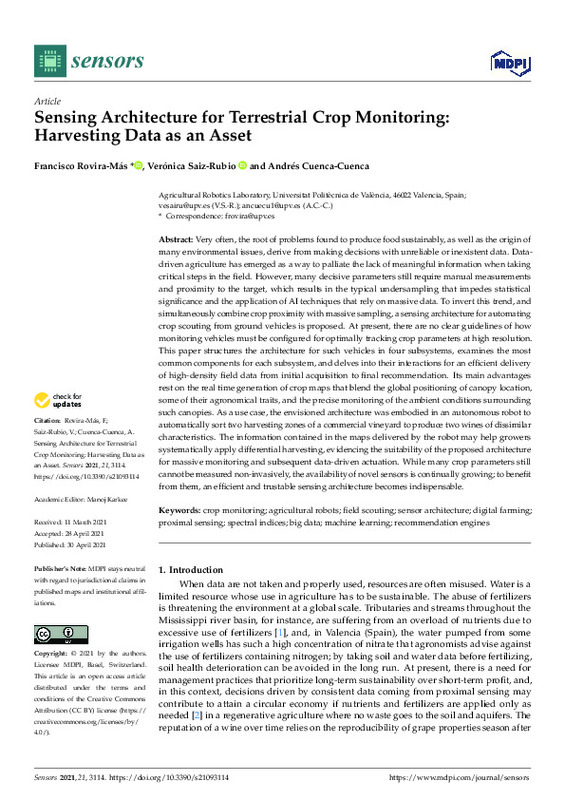JavaScript is disabled for your browser. Some features of this site may not work without it.
Buscar en RiuNet
Listar
Mi cuenta
Estadísticas
Ayuda RiuNet
Admin. UPV
Sensing Architecture for Terrestrial Crop Monitoring: Harvesting Data as an Asset
Mostrar el registro sencillo del ítem
Ficheros en el ítem
| dc.contributor.author | Rovira Más, Francisco
|
es_ES |
| dc.contributor.author | Saiz Rubio, Verónica
|
es_ES |
| dc.contributor.author | Cuenca-Cuenca, Andrés
|
es_ES |
| dc.date.accessioned | 2021-11-05T14:11:11Z | |
| dc.date.available | 2021-11-05T14:11:11Z | |
| dc.date.issued | 2021-05 | es_ES |
| dc.identifier.uri | http://hdl.handle.net/10251/176447 | |
| dc.description.abstract | [EN] Very often, the root of problems found to produce food sustainably, as well as the origin of many environmental issues, derive from making decisions with unreliable or inexistent data. Datadriven agriculture has emerged as a way to palliate the lack of meaningful information when taking critical steps in the field. However, many decisive parameters still require manual measurements and proximity to the target, which results in the typical undersampling that impedes statistical significance and the application of AI techniques that rely on massive data. To invert this trend, and simultaneously combine crop proximity with massive sampling, a sensing architecture for automating crop scouting from ground vehicles is proposed. At present, there are no clear guidelines of how monitoring vehicles must be configured for optimally tracking crop parameters at high resolution. This paper structures the architecture for such vehicles in four subsystems, examines the most common components for each subsystem, and delves into their interactions for an efficient delivery of high-density field data from initial acquisition to final recommendation. Its main advantages rest on the real time generation of crop maps that blend the global positioning of canopy location, some of their agronomical traits, and the precise monitoring of the ambient conditions surrounding such canopies. As a use case, the envisioned architecture was embodied in an autonomous robot to automatically sort two harvesting zones of a commercial vineyard to produce two wines of dissimilar characteristics. The information contained in the maps delivered by the robot may help growers systematically apply differential harvesting, evidencing the suitability of the proposed architecture for massive monitoring and subsequent data-driven actuation. While many crop parameters still cannot be measured non-invasively, the availability of novel sensors is continually growing; to benefit from them, an efficient and trustable sensing architecture becomes indispensable. | es_ES |
| dc.description.sponsorship | This research was funded by the European Union's Horizon 2020 research and innovation program with grant agreement number 737669 entitled VineScout: Intelligent decisions from vineyard robots. | es_ES |
| dc.language | Inglés | es_ES |
| dc.publisher | MDPI AG | es_ES |
| dc.relation.ispartof | Sensors | es_ES |
| dc.rights | Reconocimiento (by) | es_ES |
| dc.subject | Crop monitoring | es_ES |
| dc.subject | Agricultural robots | es_ES |
| dc.subject | Field scouting | es_ES |
| dc.subject | Sensor architecture | es_ES |
| dc.subject | Digital farming | es_ES |
| dc.subject | Proximal sensing | es_ES |
| dc.subject | Spectral indices | es_ES |
| dc.subject | Big data | es_ES |
| dc.subject | Machine learning | es_ES |
| dc.subject | Recommendation engines | es_ES |
| dc.subject.classification | INGENIERIA AGROFORESTAL | es_ES |
| dc.title | Sensing Architecture for Terrestrial Crop Monitoring: Harvesting Data as an Asset | es_ES |
| dc.type | Artículo | es_ES |
| dc.identifier.doi | 10.3390/s21093114 | es_ES |
| dc.relation.projectID | info:eu-repo/grantAgreement/EC/H2020/737669/EU/Intelligent decision from vineyard robots/ | es_ES |
| dc.rights.accessRights | Abierto | es_ES |
| dc.contributor.affiliation | Universitat Politècnica de València. Departamento de Ingeniería Rural y Agroalimentaria - Departament d'Enginyeria Rural i Agroalimentària | es_ES |
| dc.description.bibliographicCitation | Rovira Más, F.; Saiz Rubio, V.; Cuenca-Cuenca, A. (2021). Sensing Architecture for Terrestrial Crop Monitoring: Harvesting Data as an Asset. Sensors. 21(9):1-24. https://doi.org/10.3390/s21093114 | es_ES |
| dc.description.accrualMethod | S | es_ES |
| dc.relation.publisherversion | https://doi.org/10.3390/s21093114 | es_ES |
| dc.description.upvformatpinicio | 1 | es_ES |
| dc.description.upvformatpfin | 24 | es_ES |
| dc.type.version | info:eu-repo/semantics/publishedVersion | es_ES |
| dc.description.volume | 21 | es_ES |
| dc.description.issue | 9 | es_ES |
| dc.identifier.eissn | 1424-8220 | es_ES |
| dc.identifier.pmid | 33946191 | es_ES |
| dc.identifier.pmcid | PMC8125128 | es_ES |
| dc.relation.pasarela | S\436453 | es_ES |
| dc.contributor.funder | COMISION DE LAS COMUNIDADES EUROPEA | es_ES |
| dc.subject.ods | 07.- Asegurar el acceso a energías asequibles, fiables, sostenibles y modernas para todos | es_ES |
| dc.subject.ods | 03.- Garantizar una vida saludable y promover el bienestar para todos y todas en todas las edades | es_ES |
| dc.subject.ods | 13.- Tomar medidas urgentes para combatir el cambio climático y sus efectos | es_ES |
| upv.costeAPC | 1785,39 | es_ES |








